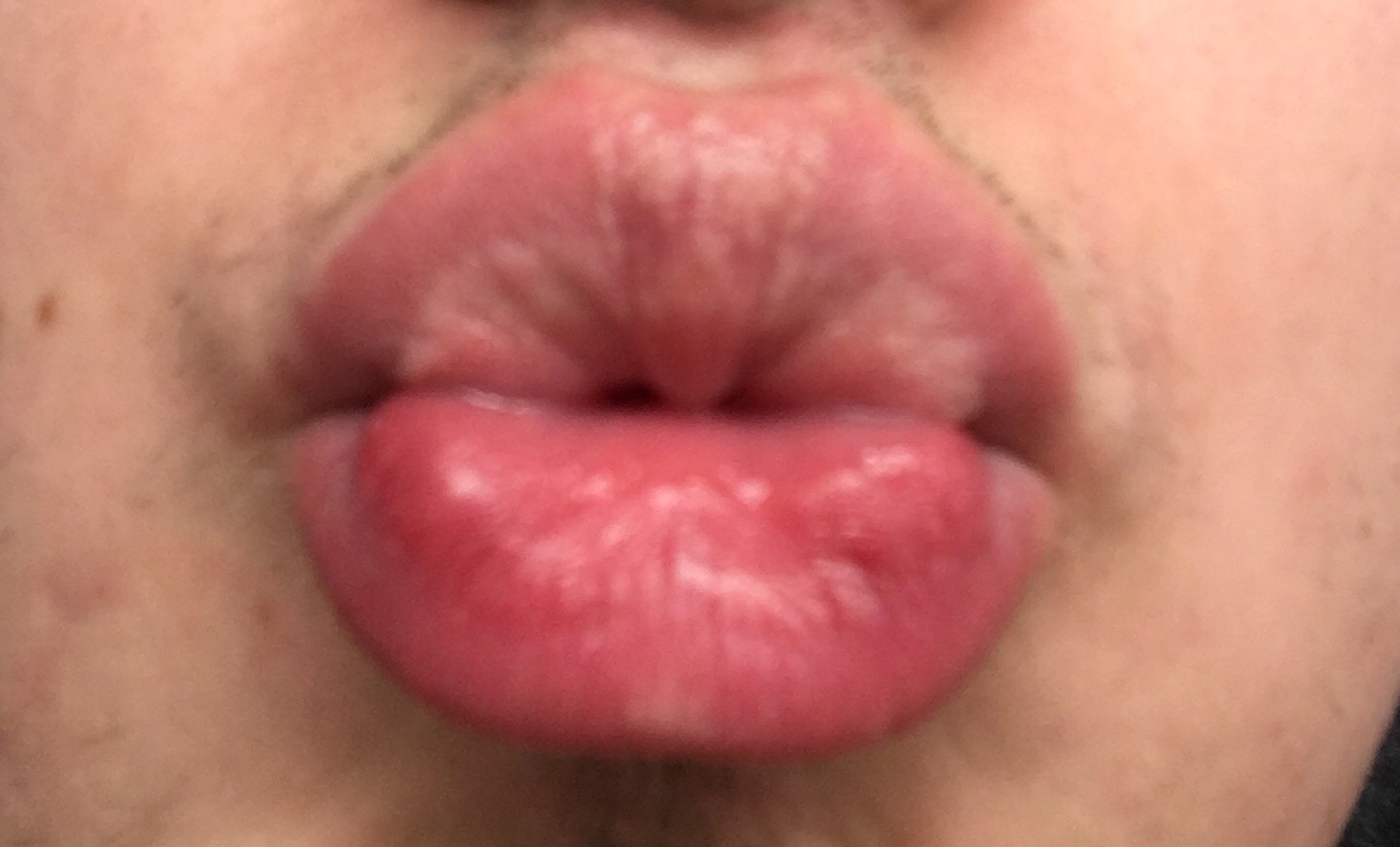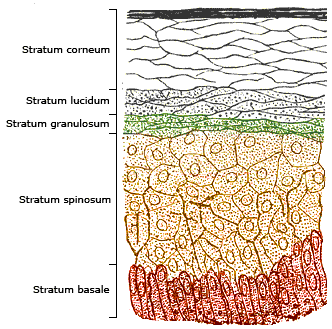|
Angiokeratoma
Angiokeratoma is a benign cutaneous lesion of capillaries, resulting in small marks of red to blue color and characterized by hyperkeratosis. ''Angiokeratoma corporis diffusum'' refers to Fabry's disease, but this is usually considered a distinct condition. Signs and symptoms Presentation includes telangiectasia, acanthosis, and hyperkeratosis. Presentation can be solitary or systemic. Multiple angiokeratomas, especially on the trunk in young people, are typical for Fabry disease, genetic disorder connected with systemic complications. Complications In some instances nodular angiokeratomas can produce necrotic tissue and valleys that can harbor fungal, bacterial and viral infections. Infections can include staphylococcus. If the lesion becomes painful, begins draining fluids or pus, or begins to smell, a doctor may recommend excision and grafting. Pathophysiology Histology Angiokeratomas characteristically have large dilated blood vessels in the superficial dermis and hyperk ... [...More Info...] [...Related Items...] OR: [Wikipedia] [Google] [Baidu] |
List Of Cutaneous Conditions
Many skin conditions affect the human integumentary system—the organ system covering the entire surface of the Human body, body and composed of Human skin, skin, hair, Nail (anatomy), nails, and related muscle and glands. The major function of this system is as a barrier against the external environment. The skin weighs an average of four kilograms, covers an area of two square metres, and is made of three distinct layers: the epidermis (skin), epidermis, dermis, and subcutaneous tissue. The two main types of human skin are: glabrous skin, the hairless skin on the palms and soles (also referred to as the "palmoplantar" surfaces), and hair-bearing skin.Burns, Tony; ''et al''. (2006) ''Rook's Textbook of Dermatology CD-ROM''. Wiley-Blackwell. . Within the latter type, the hairs occur in structures called pilosebaceous units, each with hair follicle, sebaceous gland, and associated arrector pili muscle. Embryology, In the embryo, the epidermis, hair, and glands form from the ectod ... [...More Info...] [...Related Items...] OR: [Wikipedia] [Google] [Baidu] |
Fabry's Disease
Fabry disease, also known as Anderson–Fabry disease, is a rare genetic disease that can affect many parts of the body, including the kidneys, heart, brain, and skin. Fabry disease is one of a group of conditions known as lysosomal storage diseases. The genetic mutation that causes Fabry disease interferes with the function of an enzyme that processes biomolecules known as sphingolipids, leading to these substances building up in the walls of blood vessels and other organs. It is inherited in an X-linked manner. Fabry disease is sometimes diagnosed using a blood test that measures the activity of the affected enzyme called alpha-galactosidase, but genetic testing is also sometimes used, particularly in females. The treatment for Fabry disease varies depending on the organs affected by the condition, and the underlying cause can be addressed by replacing the enzyme that is lacking. The first descriptions of the condition were made simultaneously by dermatologist Johannes ... [...More Info...] [...Related Items...] OR: [Wikipedia] [Google] [Baidu] |
John Addison Fordyce
John Addison Fordyce (February 16, 1858 - June 4, 1925) was an American professor of dermatology whose name is associated with Fordyce's spot, angiokeratoma of Fordyce, Brooke–Fordyce trichoepithelioma, and Fox–Fordyce disease. Early life and education John Addison Fordyce was born on February 16, 1858 in Guernsey County, Ohio. His father John Fordyce was of Scottish ancestry and mother Mary A. Houseman Fordyce of German. He gained his first degree in 1878 and PhD in 1901, both from Adrian College, Adrian. Career He graduated in 1881 with a degree in medicine from the Chicago Medical College, and subsequently completed his junior posts at the Cook County Hospital in Chicago. Between 1883 and 1886 he lived at Hot Springs, Ark. Between 1886 and 1888 he was in Vienna, Paris, and Berlin, from where he received his MD.. In Vienna, he studied dermatology with Moritz Kaposi. In Paris he studied under Jean Alfred Fournier, Émile Vidal and Ernest Besnier. He returned to the Stat ... [...More Info...] [...Related Items...] OR: [Wikipedia] [Google] [Baidu] |
Vittorio Mibelli
Vittorio Mibelli (18 February 1860 – 26 April 1910) was an Italian dermatologist born in Portoferraio, Elba. He studied in Siena and Florence, afterwards working in Siena as a prosector at the anatomical institute and later as an assistant at the dermatology clinic. In 1888 he gained his habilitation, spending the following year in Hamburg, working with dermatologist Paul Gerson Unna (1850–1929). In 1890 he became an associate professor and director of dermatology clinic at the University of Cagliari. Two years later, he relocated to Parma, where he held the title of full professor from 1900 until his death in 1910. Works His name is associated with two skin disorders: angiokeratoma of Mibelli and porokeratosis of Mibelli. Mibelli's disease I @ |
Cutaneous
Skin is the layer of usually soft, flexible outer tissue covering the body of a vertebrate animal, with three main functions: protection, regulation, and sensation. Other animal coverings, such as the arthropod exoskeleton, have different developmental origin, structure and chemical composition. The adjective cutaneous means "of the skin" (from Latin ''cutis'' 'skin'). In mammals, the skin is an organ of the integumentary system made up of multiple layers of ectodermal tissue and guards the underlying muscles, bones, ligaments, and internal organs. Skin of a different nature exists in amphibians, reptiles, and birds. Skin (including cutaneous and subcutaneous tissues) plays crucial roles in formation, structure, and function of extraskeletal apparatus such as horns of bovids (e.g., cattle) and rhinos, cervids' antlers, giraffids' ossicones, armadillos' osteoderm, and os penis/os clitoris. All mammals have some hair on their skin, even marine mammals like whales, dolphins ... [...More Info...] [...Related Items...] OR: [Wikipedia] [Google] [Baidu] |
Vascular Malformation
A vascular malformation is a type of vascular anomaly. They may cause aesthetic problems as they have a growth cycle, and can continue to grow throughout life. Vascular malformations of the brain include those involving capillaries, and those involving the veins and arteries. Capillary malformations in the brain are known as cerebral cavernous malformations or ''capillary cavernous malformations''. Those involving the mix of vessels are known as cerebral arteriovenous malformations (AVMs or cAVMs). The arteriovenous type is the most common in the brain. Types The International Society for the Study of Vascular Anomalies (ISSVA) classification has 5 types of Vascular Malformation. * denotes high-flow malformation Vascular malformations can also be divided into ''low-flow'' and ''high-flow'' types. Low-flow malformations involve a single type of blood or lymph vessel, and are known as ''simple vascular malformations''; high-flow malformations involve an artery. There are also mal ... [...More Info...] [...Related Items...] OR: [Wikipedia] [Google] [Baidu] |
Vein
Veins () are blood vessels in the circulatory system of humans and most other animals that carry blood towards the heart. Most veins carry deoxygenated blood from the tissues back to the heart; exceptions are those of the pulmonary and fetal circulations which carry oxygenated blood to the heart. In the systemic circulation, arteries carry oxygenated blood away from the heart, and veins return deoxygenated blood to the heart, in the deep veins. There are three sizes of veins: large, medium, and small. Smaller veins are called venules, and the smallest the post-capillary venules are microscopic that make up the veins of the microcirculation. Veins are often closer to the skin than arteries. Veins have less smooth muscle and connective tissue and wider internal diameters than arteries. Because of their thinner walls and wider lumens they are able to expand and hold more blood. This greater capacity gives them the term of ''capacitance vessels''. At any time, nearly 70% o ... [...More Info...] [...Related Items...] OR: [Wikipedia] [Google] [Baidu] |
Dermis
The dermis or corium is a layer of skin between the epidermis (skin), epidermis (with which it makes up the cutis (anatomy), cutis) and subcutaneous tissues, that primarily consists of dense irregular connective tissue and cushions the body from stress and strain. It is divided into two layers, the superficial area adjacent to the epidermis called the papillary region and a deep thicker area known as the reticular dermis.James, William; Berger, Timothy; Elston, Dirk (2005). ''Andrews' Diseases of the Skin: Clinical Dermatology'' (10th ed.). Saunders. Pages 1, 11–12. . The dermis is tightly connected to the epidermis through a basement membrane. Structural components of the dermis are collagen, elastic fibers, and Ground substance, extrafibrillar matrix.Marks, James G; Miller, Jeffery (2006). ''Lookingbill and Marks' Principles of Dermatology'' (4th ed.). Elsevier Inc. Page 8–9. . It also contains mechanoreceptors that provide the sense of touch and thermoreceptors that provide ... [...More Info...] [...Related Items...] OR: [Wikipedia] [Google] [Baidu] |
Fordyce's Spots
Fordyce spots (also termed Fordyce granules) are harmless and painless visible sebaceous glands typically appearing as white/yellow small bumps or spots on the inside of lips or cheeks, gums, or genitalia. They are common, and are present in around 80% of adults. Treatment is generally not required and attempts to remove them typically result in pain and scarring. Their cause is unclear, and they are not associated with hair follicles. Diagnosis is done by visualisation. They may appear similar to genital warts or molluscum. They were first described in 1896 by American dermatologist John Addison Fordyce. History Fordyce spots are named after the American dermatologist John Addison Fordyce, who first described them in 1896.Fordyce first described them in 1896. Classification Sebaceous glands are normal structures of the skin but may also be found ectopically in the mouth, where they are referred to as ''oral Fordyce granules'' or ectopic sebaceous glands. On the foreskin, ... [...More Info...] [...Related Items...] OR: [Wikipedia] [Google] [Baidu] |
Who Named It
''Whonamedit?'' is an online English-language dictionary of medical eponyms and the people associated with their identification. Though it is a dictionary, many eponyms and persons are presented in extensive articles with comprehensive bibliographies. The dictionary is hosted in Norway Norway, officially the Kingdom of Norway, is a Nordic countries, Nordic country located on the Scandinavian Peninsula in Northern Europe. The remote Arctic island of Jan Mayen and the archipelago of Svalbard also form part of the Kingdom of ... and was developed by medical historian Ole Daniel Enersen. References External links * Medical websites Medical dictionaries Eponyms in medicine {{online-dict-stub ... [...More Info...] [...Related Items...] OR: [Wikipedia] [Google] [Baidu] |
Epidermis (skin)
The epidermis is the outermost of the three layers that comprise the skin, the inner layers being the dermis and hypodermis. The epidermal layer provides a barrier to infection from environmental pathogens and regulates the amount of water released from the body into the atmosphere through transepidermal water loss. The epidermis is composed of multiple layers of flattened cells that overlie a base layer ( stratum basale) composed of columnar cells arranged perpendicularly. The layers of cells develop from stem cells in the basal layer. The thickness of the epidermis varies from 31.2μm for the penis to 596.6μm for the sole of the foot with most being roughly 90μm. Thickness does not vary between the sexes but becomes thinner with age. The human epidermis is an example of epithelium, particularly a stratified squamous epithelium. The word epidermis is derived through Latin , itself and . Something related to or part of the epidermis is termed epidermal. Structure ... [...More Info...] [...Related Items...] OR: [Wikipedia] [Google] [Baidu] |







